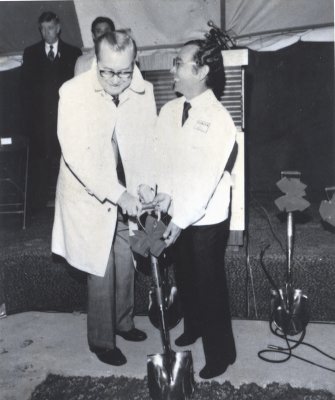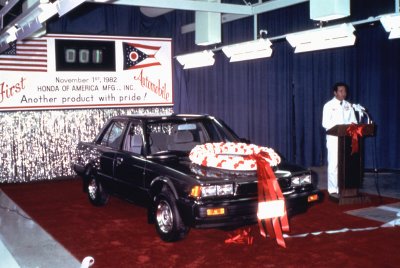20 Years Ago Honda Proved Cars "Made in USA" Can Be As Good as "Made in Japan"
 Marysville Auto Plant (MAP) ground breaking ceremony (Dec. 2nd, 1980) Governor Rhodes and Kiyoshi Kawashima, President of Honda Motor Co., Ltd. (HMC). |
 First Accord Off The Marysville Line -November 1, 1982 |
MARYSVILLE, Ohio November 7, 2002, The AP published this feature story: "Twenty years ago, Honda Motor Co. became the first Japanese automaker to start making cars on American soil, pushing the Honda Accord off an assembly line near this central Ohio city.
Honda's attention to quality, fuel efficiency and customer service rubbed off on U.S. automakers, who scrambled to compete against the new kid on the block, analysts say.
Honda had been making cars for 20 years when it built the Marysville plant 30 miles northwest of Columbus, increasing its U.S. sales.
"It was a decision that was more successful than any one that Honda could have imagined," said Michael Smitka, an economics professor at Washington and Lee University who follows international auto trade. "Here's a company that has been so successful that it's gone from zip to a major presence in the U.S. in only four decades."
Honda holds about 10 percent of the U.S. passenger-car market. Automotive News reports Honda sold about 650,000 of the approximately 6.5 million passenger cars sold in the United States during the first nine months of 2002. Of the Honda cars sold, about 542,000 were made in the United States.
Ann Wendt, associate professor of management at Wright State University, said Honda's American presence was a wake-up call to General Motors Corp., Ford Motor Co. and Chrysler Group.
"What Honda has done is make the Big Three sit up and take notice and force the Big Three automakers to pay more attention to things like fuel efficiency, customer service, quality products," Wendt said.
Honda's success also prompted other foreign automakers to open production plants in the United States, analysts say.
"Honda led the way and was the straw that broke the back of the Big Three dominance," Smitka said.
Bruce Belzowski, senior research associate at the Office for the Study of Automotive Transportation at the University of Michigan, said producing Japanese cars in the United States made buying them more acceptable to some Americans.
"And one could argue that if the Japanese had not shown up, we would be driving cars of lesser quality," Belzowski said.
Honda has produced more than 9 million cars at its Marysville and East Liberty auto plants. The company employs about 13,000 workers at its four Ohio plants, which include a motorcycle plant in Marysville and an engine plant in Anna.
"We set out with a concept that was quite simple: to produce quality automobiles close to the customer," said John Adams, Honda of America Manufacturing's senior vice president.
Smitka said that before building the U.S. plant, Honda had built a U.S. customer base by producing well-made, competitively priced cars that got good gas mileage. He said Honda was able to exploit what some Americans perceived as declining quality of U.S.-made cars.
"They showed contrary to expectations you really could build a car that was competitive in cost and competitive in quality with an American work force," he said.
Smitka said Honda has trained its workers well and tried to establish a partnership with them, referring to them as associates. The company's wages and benefits have enabled it to fend off any serious attempt to unionize workers.
"That has given them flexibility where they don't have to worry about a contract and a shop steward every time they want to shift around the plant," he said.
In addition, unlike many U.S. automakers, Honda has few U.S. retirees, saving money in pension and health-care costs.
"Honda is still young," Smitka said.


